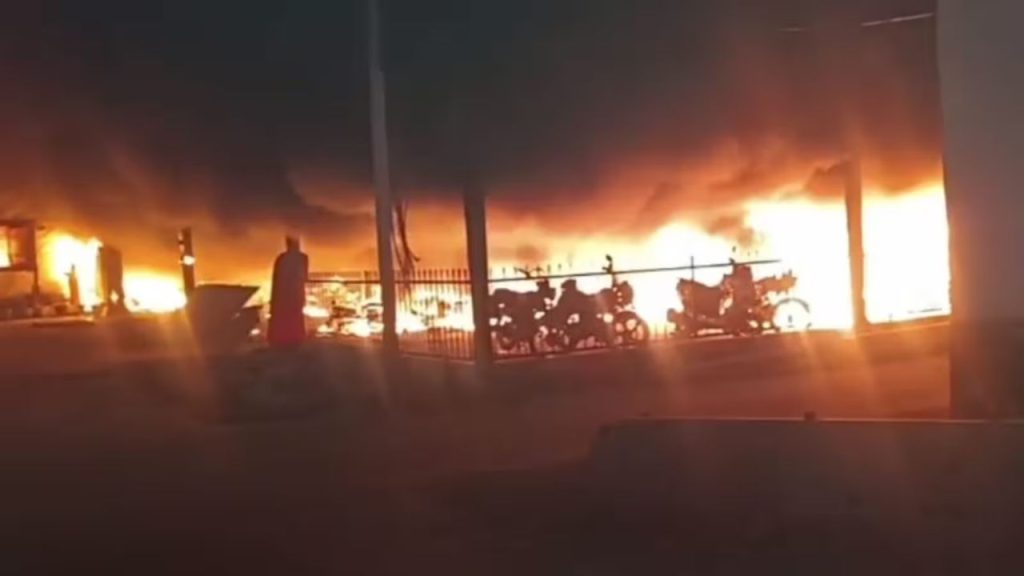
A massive fire broke out at the Varanasi Railway Station parking lot, leading to the destruction of more than 200 vehicles. This incident has captured the attention of both local residents and the broader public due to the scale of the blaze and the significant damage caused. The event highlights concerns about safety, emergency response preparedness, and the infrastructure surrounding major transportation hubs in India.
The Fire Incident
The fire, which began in the early hours of the morning, quickly spread across a large section of the parking area at Varanasi Railway Station. Witnesses reported seeing thick plumes of black smoke rising into the sky, visible from miles away. As fire trucks rushed to the scene, it became evident that the blaze was more intense than initially anticipated. Local residents who had parked their vehicles at the station for short-term or long-term use watched in disbelief as their cars, motorcycles, and other vehicles were consumed by the flames.
The fire was believed to have started in a cluster of parked vehicles, with the flammable materials inside them fueling the rapid spread of the fire. Within minutes, a large portion of the parking lot was engulfed in flames. The incident occurred during a time when the station was not particularly crowded, which may have helped in minimizing casualties or injuries. However, there were reports of a few minor injuries, mainly from people who had been near the fire when it started.
The Response
Firefighters from the Varanasi district and surrounding areas were immediately called to the site. They worked tirelessly to control the fire, but the presence of numerous vehicles made the task extremely challenging. It took several hours before the fire was brought under control. The heat from the flames was so intense that it melted parts of nearby structures and caused significant damage to the surrounding area, including the station’s infrastructure.
Local authorities and railway officials also rushed to the scene, assessing the damage and coordinating the emergency response. Given the scale of the fire, it was clear that a major investigation would follow to determine its cause. Several theories circulated regarding the origin of the blaze, including electrical short circuits or human error, but no official cause had been confirmed as of the latest reports.
Impact on the Community
The destruction of more than 200 vehicles in the fire had a profound impact on those who had parked their vehicles at the railway station. Many of the affected individuals were daily commuters who used the station regularly for travel. For them, the loss of a vehicle represented not just a financial blow but also a significant disruption to their daily routine. People who rely on their vehicles for transportation were left grappling with the consequences of the blaze.
Additionally, the incident raised questions about the safety measures in place at one of India’s busiest railway stations. The Varanasi Railway Station is a major hub for both passenger and freight traffic, with thousands of travelers passing through every day. While the station is well-equipped to handle the flow of people, the parking lot, where the fire started, had not been equipped with sufficient safety protocols to prevent such an incident. This has raised concerns about the adequacy of fire safety measures at various railway stations across the country.
Infrastructure and Safety Concerns
The fire at Varanasi Railway Station underscores the growing need for improvements in infrastructure and safety measures at transportation hubs. In many cities, including Varanasi, the volume of people using public transportation systems has increased drastically in recent years, leading to higher demand for parking spaces and services. However, the accompanying safety infrastructure has not always kept pace with this growth.
In the case of Varanasi, the parking lot lacked visible fire suppression systems, such as sprinklers or fire alarms, which might have helped mitigate the scale of the damage. Additionally, the layout of the parking lot may have contributed to the rapid spread of the fire. With vehicles packed tightly together, the fire spread quickly from one car to another, causing a chain reaction that was difficult to contain.
The incident highlights the need for better urban planning and design, especially when it comes to managing high-traffic areas such as railway stations, bus terminals, and airports. While improvements to the station’s infrastructure are underway in some parts of India, the Varanasi fire serves as a wake-up call to other cities to reassess their safety measures.
The Economic Impact
Beyond the immediate destruction of vehicles, the fire at Varanasi Railway Station has broader economic implications. The damaged vehicles, most of which were privately owned, represented significant financial losses for their owners. Insurance claims will likely follow, but for many, the loss of a car or motorcycle may take years to recover from, especially for those without comprehensive insurance coverage.
The fire also had a more indirect economic impact on local businesses. Varanasi is a major tourist destination, and the station serves as a key gateway for travelers arriving by train. The incident caused a temporary disruption in services, with delays and cancellations affecting the schedules of some passengers. Though the station has since returned to normal operation, the loss of business, even in the short term, can be significant for the vendors, taxis, and other services that operate around the station.
Investigation and Accountability
Following the incident, local authorities launched an investigation to determine the cause of the fire. While it is too early to draw conclusions, the authorities are looking into several possible factors, including the possibility of a faulty electrical system, human error, or an external factor such as arson. The investigation is expected to be thorough, as this is one of the largest fires in recent memory at a railway station in India.
In the coming days, railway officials will also face questions about their role in the disaster. The incident raises concerns about the preparedness of railway stations to handle emergencies of this magnitude. It is likely that there will be calls for reforms and the implementation of stricter fire safety standards across the network of Indian railway stations.
Lessons Learned
The fire at Varanasi Railway Station serves as a tragic reminder of the importance of safety in public spaces, particularly those that handle large volumes of people and vehicles. As the investigation continues and authorities work to mitigate the damage, the key lesson to be learned is the need for proactive measures to prevent such disasters from occurring in the future.
Moving forward, the government and railway officials must prioritize safety and ensure that stations and their surrounding infrastructure are adequately equipped to handle emergencies. This could include the installation of advanced fire detection and suppression systems, better training for staff in emergency procedures, and improvements to the design and layout of parking facilities.
Conclusion
The massive blaze at Varanasi Railway Station and the destruction of over 200 vehicles is a sobering event that underscores the need for improved safety measures at transportation hubs across India. While the immediate damage to the station and the affected individuals is considerable, the incident provides an opportunity for reflection and reform. By learning from this tragedy and making necessary changes to infrastructure and safety protocols, authorities can prevent similar disasters in the future, ensuring the safety of millions of people who rely on these transportation systems every day.
